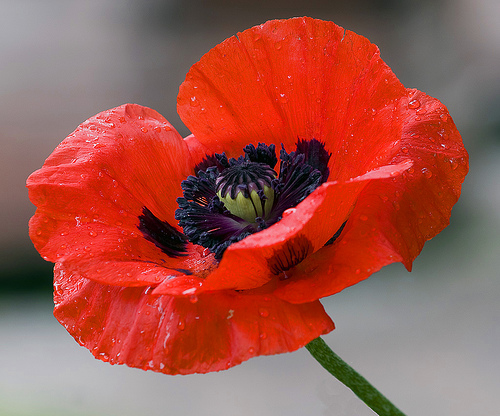Oriental Poppy A Beauty in Bloom
By Jos Van Hage
Saturday, July 10, 2010 03:48 AM
A perennial that is sure to catch your eye when in bloom is the 'Oriental Poppy' (Papaver orientale).
The cup shaped flowers come in white, pink, salmon, orange and red and certainly stand out as they can span 4-6 inches across and stand on top of the foliage on 2-3 foot tall stiff hairy stems. Its not only the stems that are hairy but the large thistle like leaves are also hairy.
The flowers themselves look as if they are made of crepe paper and when looking down into them many have a dark center with black stamens that surround the decorative ornate, ovary or seed pod.
Oriental poppies come into bloom in early summer starting off as large fuzzy buds that open up into the flower and after the petals have fallen off, there remains a large unique seed pod, which is also very decorative and can be used in dried arrangements. The flowers can also be used as cut flowers but should be cut just as the bud begins to break open.
As the seed pod ripens and turns brown the seeds will spill out of the pores and reseed themselves or be eaten by the birds.
After the oriental poppy has finished blooming the foliage will die back and the plant will go dormant until early fall when it produces new foliage. Because the foliage dies back during the summer plant other plants such as late blooming perennials or annuals around the oriental poppy to fill in the gap left open.
Oriental poppies are propagated by seed or plant division. They can be divided every 5 years in the fall. They have a very long tap root and are not always the easiest plant to transplant. An easier way would be to transplant the small young plants that often develop around the edge of the old plant. Poppies can also be started from seed but seed should first be placed in the freezer for 48 hours before sowing to take them out of dormancy. Oriental poppies grow best in full sun in well drained soil. They require very little water and when in the dormant stage through the summer do not overwater them.
Indigenous to Western Asia the Oriental poppy is one of the longest living perennials that is rarely bothered by pests, disease or deer. It is a hardy perennial that has been around for hundreds of years and grows very well in our Prince George area. They are easy to grow and do not require a lot of maintenance or care and do not need to be deadheaded as the seedpods are very decorative as well. We have had them growing in our perennial beds at home and have had them re-bloom in late summer on occasion by removing the seed pods down at ground level after they have finished blooming. They are known to attract birds, bees and butterflies as well as many admirers who comment on the brilliance of the flowers.
-Jos
Jos Van Hage owns and operates two Art Knapp Garden centres in Prince George,
- Highway 16 west at Kimball Road
- Highway 97 North at Northwood Pulpmill Road
Previous Story -
Next Story
Posted on Saturday, July 10, 2010 03:48 AM in
Home and Garden by
Jos Van Hage










